The scope of this page is to explore the use of ETSI (Nested) Network Services model at Design Time and Run Time in the context of 5G Network Slicing.
The Guilin Service IM allows for a (nested) Network Service (NS) model that is referenced from an ONAP Service. Multiple ONAP Services may reference the same NS Descriptor and multiple ONAP Service Instances may reference an NS Instance.
Since the NS can be composed VNFs, CNFs, PNFs and nested NSs, the ETSI NS model is well suited to describe the hierarchical structure of 3GPP Network Slice Subnets.
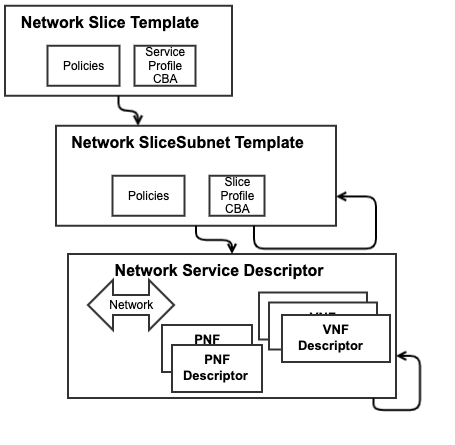
Design Time:
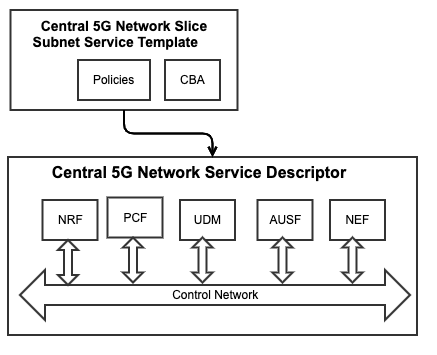
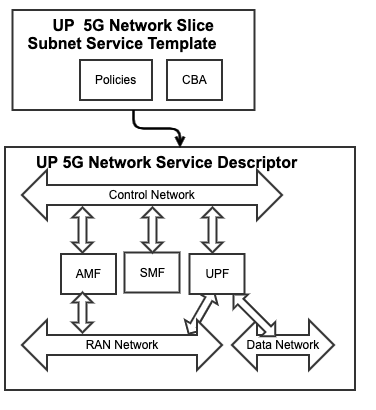
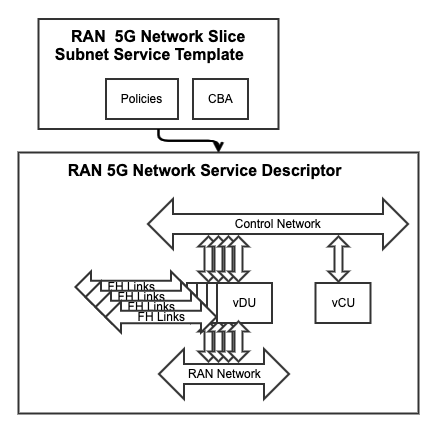
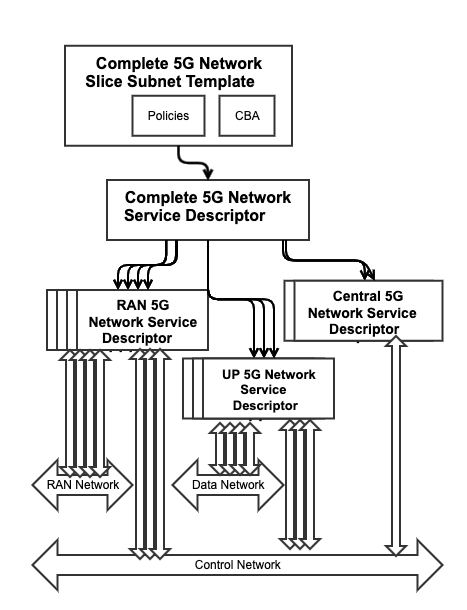
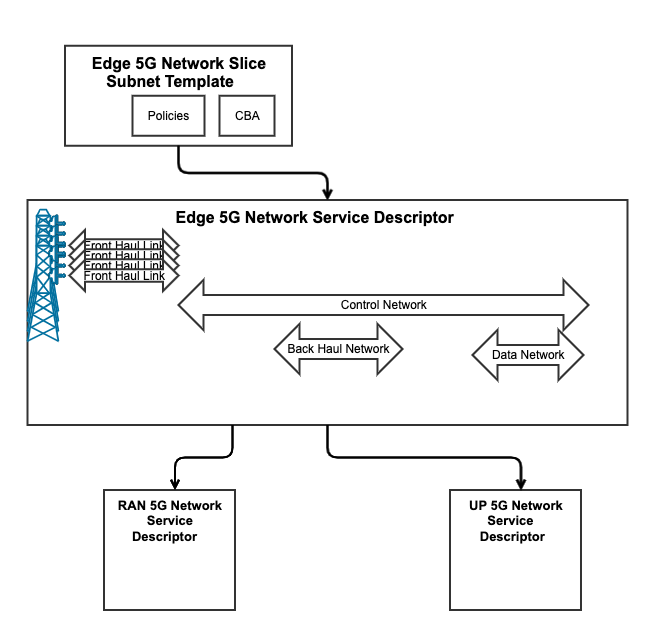
Design Sequence:
- Onboard 5G Core NFs (NRF, PCF, UDM, AUSF, NEF, AMF, SMF, UPF, ...) into SDC
- Onboard RAN NFs (vCU, vDU) into SDC
- In SDC, design a "Central" Network Service composed of
- "Central" NFs (NRF, PCF, UDM, AUSF, NEF)
- Virtual Link (Control Network) for the SBA interface
- SAP(s) for all of the exposed entry points
- SDC distribute the resulting SOL007 NS package to the ETSI Catalog (and any one else interested, SO??)
- In SDC, design a "User Plane" Network Service composed of:
- "user plane" NFs (AMF, SMF, UPF)
- Virtual Link (Control Network) for the SBA interface
- Virtual Link (RAN Network) for the interface to the RAN components
- Virtual Link (Data Network) for the (external) data/internet interface
- SAP(s) for all of the exposed entry points
- SDC distribute the resulting SOL007 NS package to the ETSI Catalog (and any one else interested, SO??)
- In SDC, design a "RAN" Network Service composed of:
- "RAN" NFs (CU, DU)
- Virtual Link (Control Network) for the OAM interface
- Virtual Link (RAN Network) for the interface to the RAN components
- Virtual Link (Front-Haul) for the radio interface
- SAP(s) for all of the exposed entry points
- SDC distribute the resulting SOL007 NS package to the ETSI Catalog (and any one else interested, SO??)
- In SDC, design a "Complete" Network Service composed of:
- Scalable reference to the Central NS
- Scalable reference to the UP NS
- Scalable reference to the RAN NS
- Virtual Link (Control Network) for the OAM interface
- Virtual Link (Data Network) for the (external) data/internet interface
- Virtual Link (RAN Network) for the interface to the RAN components
- SAP(s) for all of the exposed entry points
- SDC distribute the resulting SOL007 NS package to the ETSI Catalog (and any one else interested)
- In SDC, Design a "Central" Service composed of
- A reference to the "Central" Network Service
- A CDS blueprint (CBA) for configuring the "Central" Service
- Behavioral policies for the "Central" Service
- SDC distribute the resulting "Central" Service package
- In SDC, Design a "User Plane" Service composed of
- A reference to the "UP" Network Service
- A CDS blueprint (CBA) for configuring the "UP" Service
- Behavioral policies for the "UP" Service
- SDC distribute the resulting "UP" Service package
- In SDC, Design a "RAN" Service composed of
- A reference to the "RAN" Network Service
- A CDS blueprint (CBA) for configuring the "RAN" Service
- Behavioral policies for the "RAN" Service
- SDC distribute the resulting "RAN" Service package
- In SDC, Design a "Complete" Service composed of
- A reference to the "Complete" Network Service
- A CDS blueprint (CBA) for configuring the "Complete" Service
- Behavioral policies for the "Complete" Service
- SDC distribute the resulting "Complete" Service package
Runtime
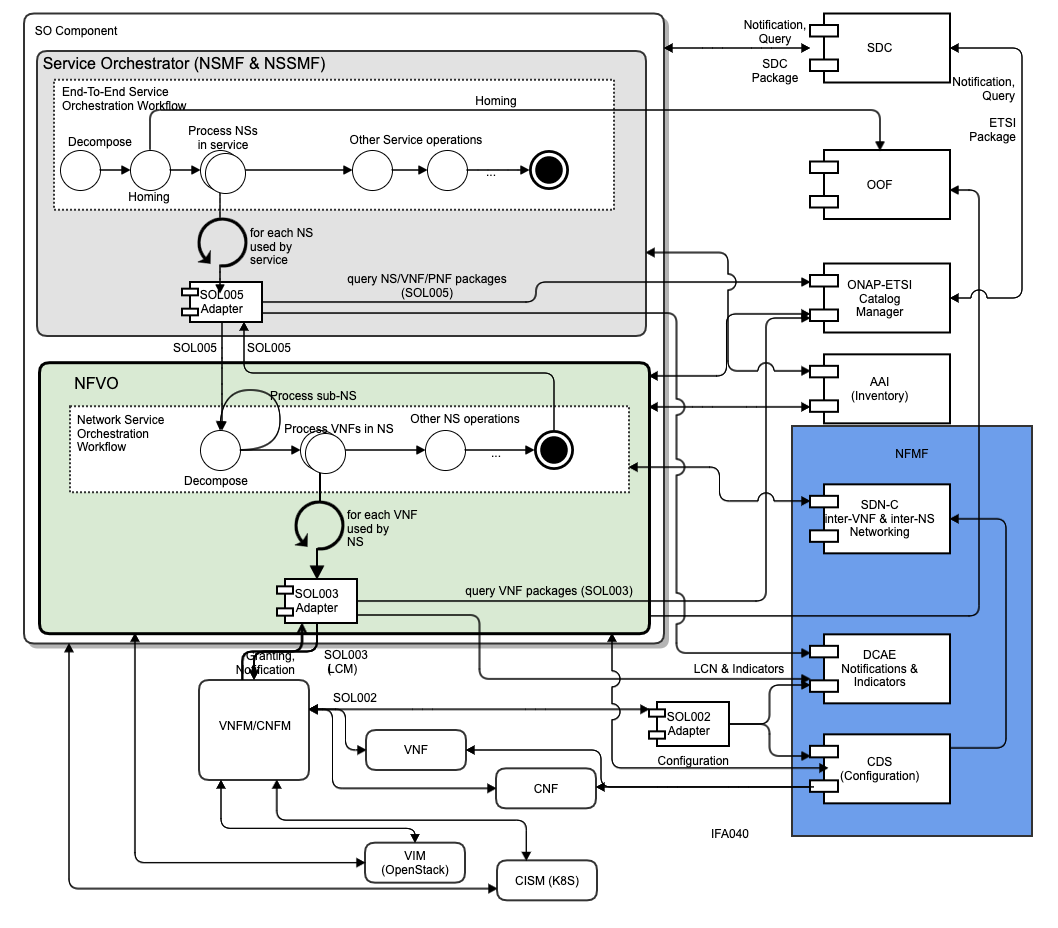
Starting state:
- SOL004 Packages for Central, UP and RAN NFs in the ETSI Catalog
- SOL007 Packages for Central, UP, RAN and Complete NSs in the ETSI Catalog
- Service Packages for Central, UP, RAN, and Complete NSs in SO Catalog
- Policies available in DCAE
- CBAs in CDS
- VIM & CISM regions (NE, SE, S, C, N, NW, SW) registered in A&AI
- 6 RAN/UP Sites and one Central Site available and registered in A&AI
Instantiate nationwide eMBB Slice :
- CSMF(eMBB Nationwide) => NSMF (eMBB Nationwide Service Profile)
- NSMF creates/selects eMBB Nationwide Slice Profile
- NSMF => NSSMF (eMBB Nationwide Slice Profile, Complete Network Slice Subnet Service Template)
- NSSMF Matches eMBB Nationwide Slice Profile and decomposes it to:
- NE (UP Network Slice Subnet Service, RAN Network Slice Subnet Service)
- SE (UP Network Slice Subnet Service, RAN Network Slice Subnet Service)
- S (UP Network Slice Subnet Service, RAN Network Slice Subnet Service)
- C (Central Network Slice Subnet Service)
- N (UP Network Slice Subnet Service, RAN Network Slice Subnet Service)
- NW (UP Network Slice Subnet Service, RAN Network Slice Subnet Service)
- SW (UP Network Slice Subnet Service, RAN Network Slice Subnet Service)
- NSSMF creates Configuration data and Slice Profile for each instance:
- NE (UP, RAN)
- SE (UP, RAN)
- S (UP, RAN)
- C (Central)
- N (UP, RAN)
- NW (UP, RAN)
- SW (UP, RAN)
- NSSMF Instantiates Network Slice Subnet Instances:
- NSSMF => NSSMF (C, Central)
- NSSMF (C, Central) => SO (Central Network Slice Service (C Parameters)
- SO => NFVO (Central Network Slice Network Service)
- NFVO sets up network connection points to appropriate networks and works with VNFM(s) to Instantiate VNFs and CNFs
- NSSMF configures Central VNF/CNF/PNFs(C eMBB data)
- NSSMF(C) registers C NSSI (Capacity Available, Capacity Allocated ) in A&AI
- NSSMF => NSSMF(NE, UP)
- NSSMF(NE, UP) => SO( UP Network Slice Service (NE Parameters))
- NSSMF => NSMF(NE, RAN)
- NSSMF(NE, RAN) => SO (RAN Network Slice Service (NE Parameters)
- ...
- NSSMF => NSSMF (C, Central)
- Resulting Network Service Deployment:
-
- NSSMF registers Nationwide NSSI (Capacity Available, Capacity Allocated ) with A&AI
- NSMF registers Nationwide eMBB Slice
- CSMF completes
Resulting Instance info:
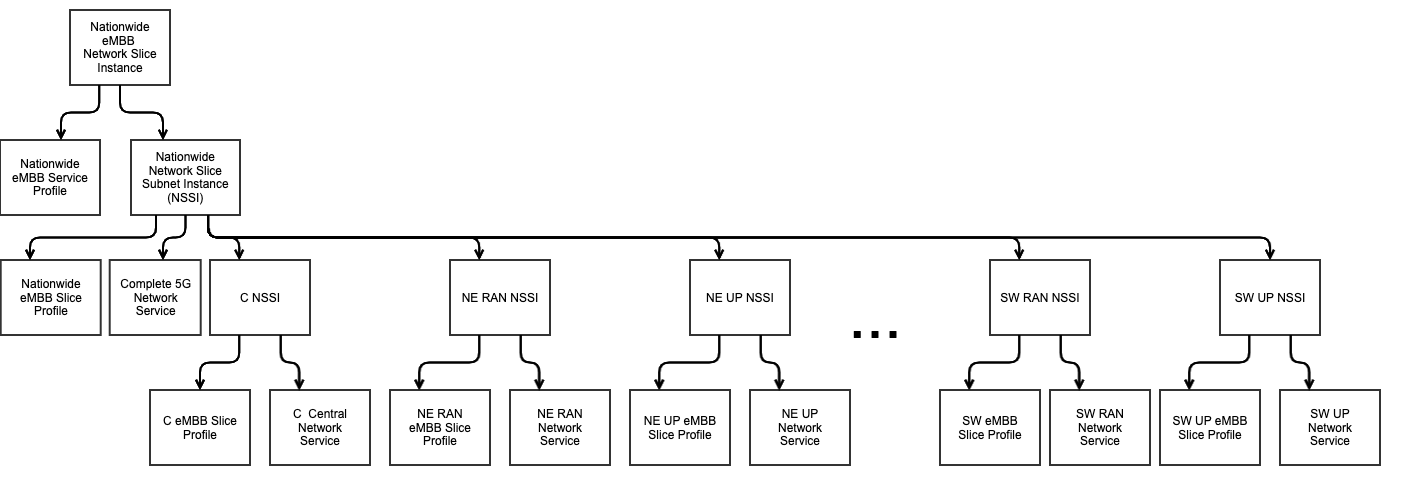
New Slice Request (NE Enterprise):
- CSMF(NE Enterprise) => NSMF (NE Enterprise Service Profile)
- NSMF creates NE Enterprise Slice Profile
- NSMF => NSSMF (NE Enterprise Slice Profile)
- NSSMF Matches NE Enterprise Slice Profile to:
- NE (UP Network Slice Subnet Service, RAN Network Slice Subnet Service)
- C (Central Network Slice Subnet Service)
- NSSMF create Configuration data and Slice Profile for each instance:
- NE (UP, RAN) Slice Profiles
- C (Central) Slice Profile
- NSSMF Identifies existing Network Slice Subnet Instances with enough capacity for NE Enterprise Slice Profile:
- NE RAN NSSI
- NE UP NSSI
- C Central NSSI
- NSSMF => NSSMF (C)
- NSSMF(C) configures Central VNFs(C NE Enterprise data)
- NSSMF(C) update C NSSI (Capacity Available, Capacity Allocated )
- NSSMF => NSSMF(NE, UP)
- NSSMF(NE, UP) configures NE, UP VNFs(UP NE Enterprise data)
- NSSMF(NE, RAN) updates NE RAN NSSI (Capacity Available, Capacity Allocated )
- NSSMF => NSMF(NE, RAN)
- NSSMF(NE, UP) configures NE, UP VNFs(UP NE Enterprise data)
- NSSMF(NE, RAN) updates NE UP NSSI (Capacity Available, Capacity Allocated )
- NSSMF registers NE Enterprise NSSI (Capacity Available, Capacity Allocated ) with A&AI
- NSMF registers NE Enterprise Slice
- CSMF completes
Resulting Instance info:
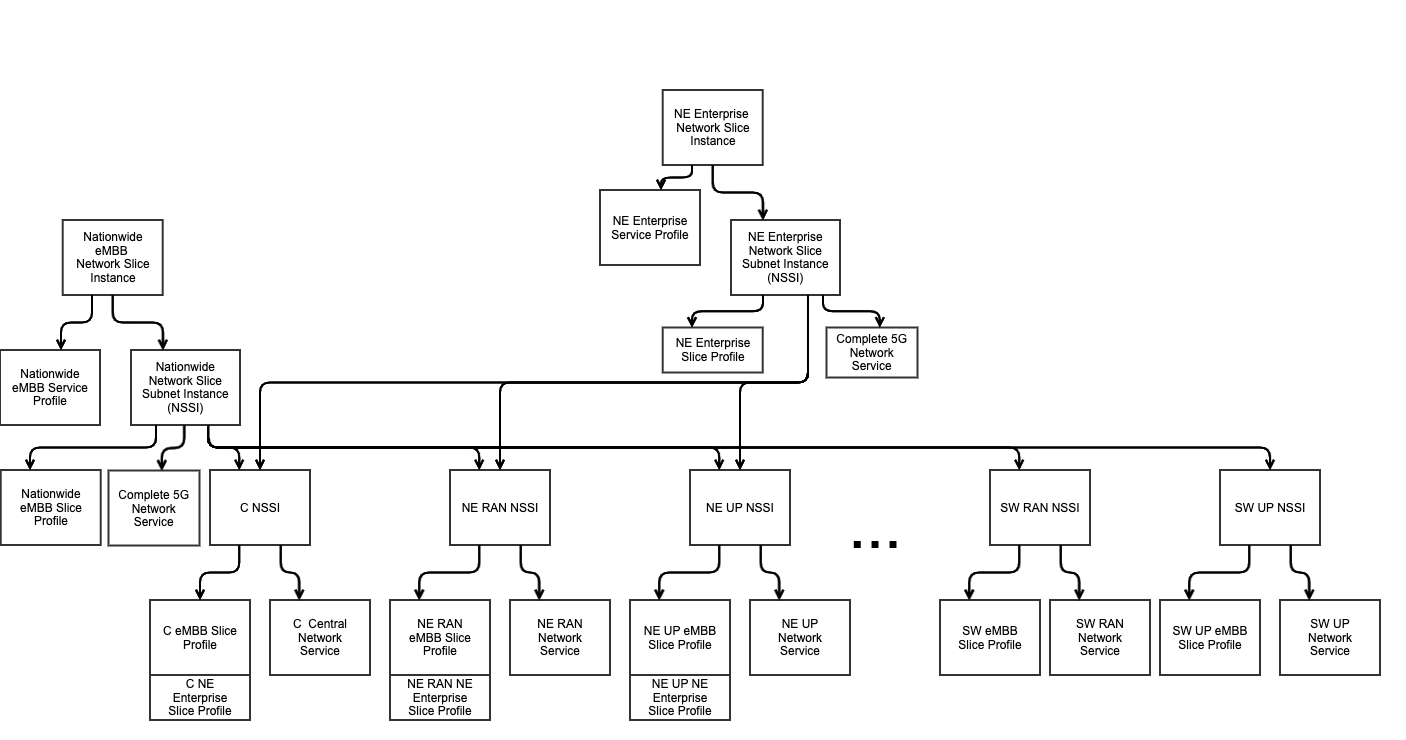
New mIOT Slice
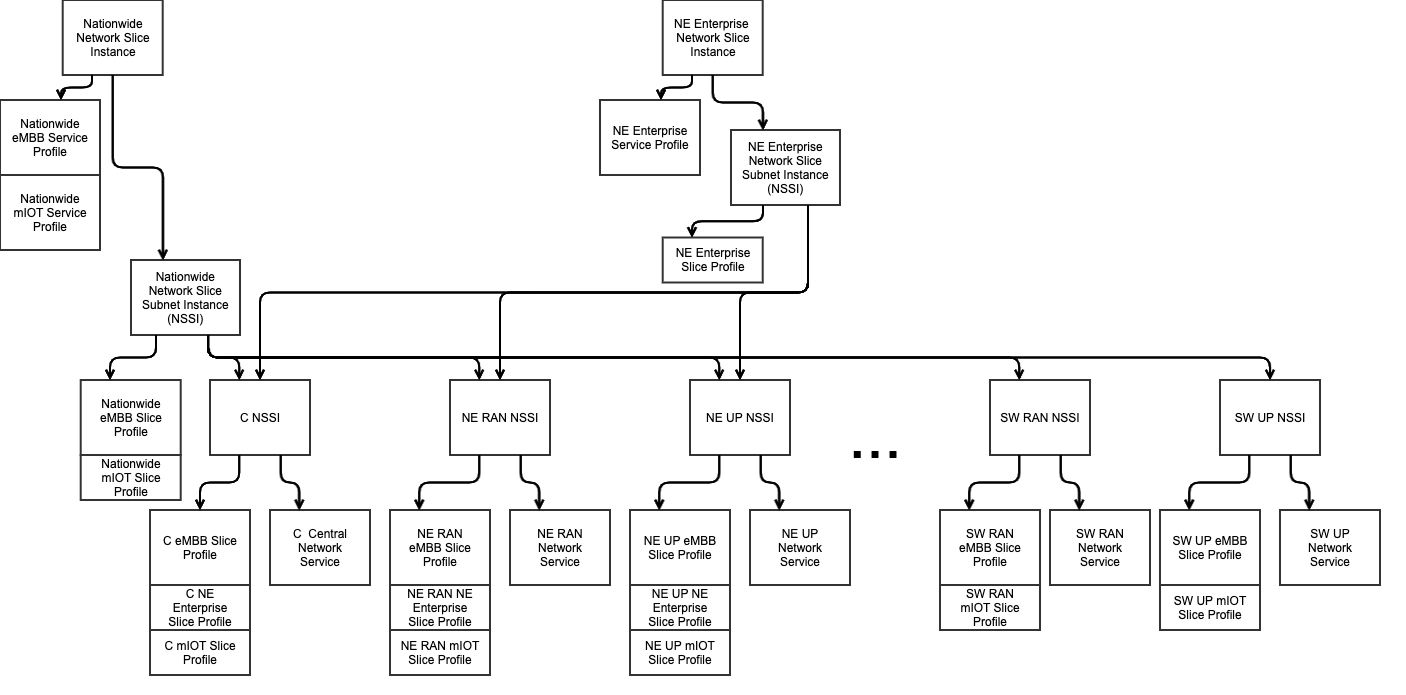
Example of adding a new URLLC Slice including Transport
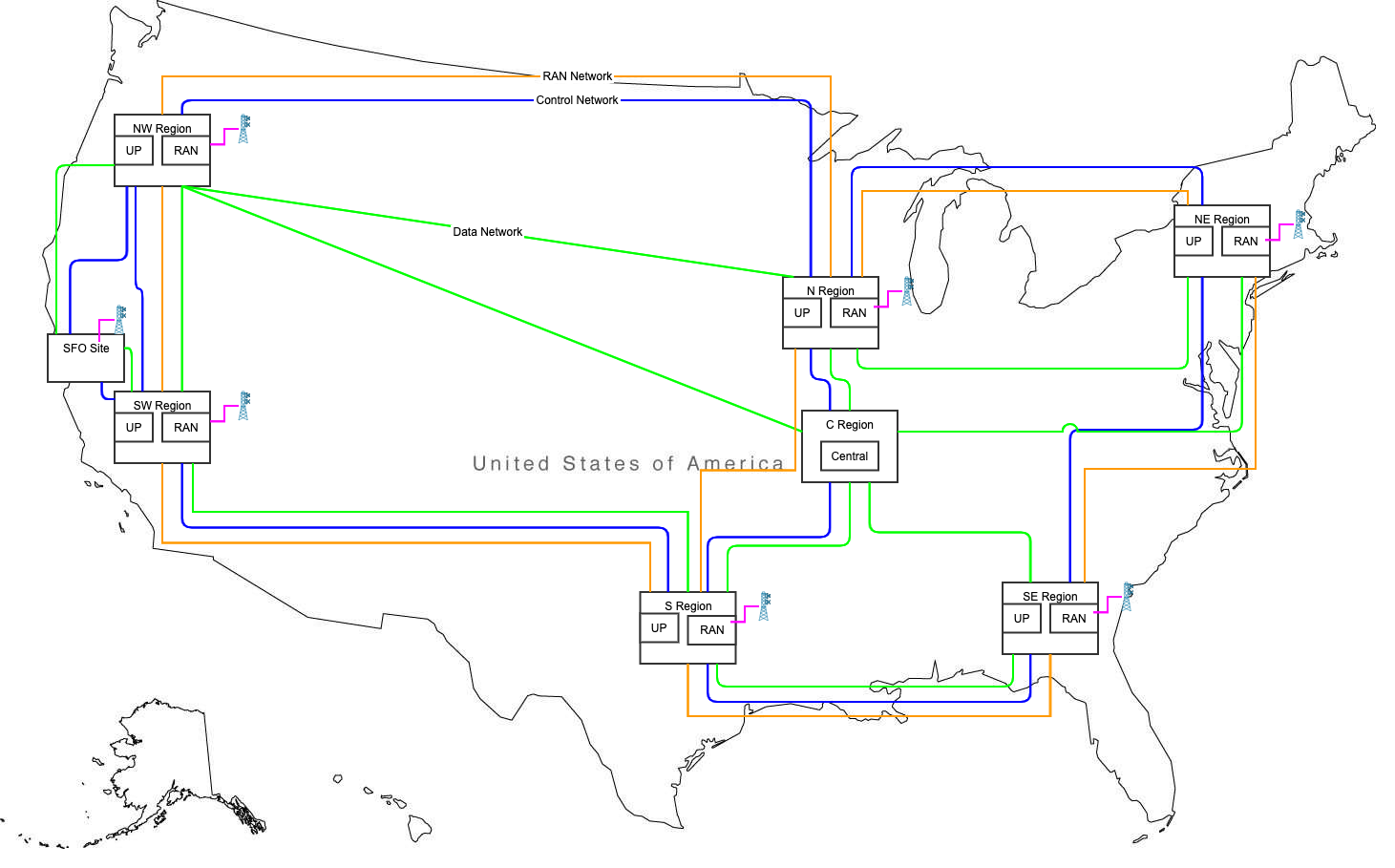
- CSMF(SFO URLLC) => NSMF (SFO URLLC Service Profile)
- NSMF creates SFO URLLC Slice Profile
- NSMF => NSSMF (SFO URLLC Slice Profile)
- NSSMF Matches SFO URLLC Slice Profile to:
- SFO Site (Edge Network Slice Subnet Service)
- C (Central Network Slice Subnet Service)
- Nationwide Slice Subnet Service ("Data Network" and "Control Network")
- SFO Site Radio Links
- NSSMF create Configuration data and Slice Profile for each instance:
- SFO (Edge) Slice Profile
- C (Central SFO URLLC) Slice Profile
- Nationwide SFO URLLC Slice Profile
- NSSMF Identifies existing Nationwide NSSI and C NSSI with enough capacity for SFO URLLC Slice Profile but needs to instantiate new Edge NSSI:
- Existing Nationwide NSSI (Data Network and Control Network)
- Existing C NSSI
- New SFO URLLC NSSI
- NSSMF => NSSMF (C, Central SFO URLLC Slice Profile)
- NSSMF(C) configures Central VNFs(C Central SFO URLLC data)
- NSSMF(C) update C NSSI (Capacity Available, Capacity Allocated )
- NSSMF => NSSMF(Nationwide, Nationwide SFO URLLC Slice Profile)
- NSSMF(Nationwide, Complete) configures Nationwide SFO URLLC Data Network and Control Network
- NSSMF(Nationwide, Complete) updates Nationwide NSSI (Capacity Available, Capacity Allocated )
- NSSMF => NSMF(SFO, Edge)
- NSSMF (SFO, Edge) => SO (Edge Network Slice Service (SFO Parameters)
- SO => NFVO (Edge Network Slice Network Service)
- NFVO Configures "internal RAN Network"
- NFVO => NFVO (RAN NS)
- NFVO (RAN) sets up network connection points (FH Links, Internal RAN and Control networks) and works with VNFM(s) to Instantiate VNFs and CNFs
- NFVO => NFVO (UP NS)
- NFVO (UP) sets up network connection points (Internal RAN, Control and Data networks) and works with VNFM(s) to Instantiate VNFs and CNFs
- NSSMF configures SFO Edge VNF/CNF/PNFs(SFO, SFO URLLC data)
- NSSMF registers SFO Edge NSSI (Capacity Available, Capacity Allocated ) in A&AI
- NSSMF registers SFO URLLC NSSI (Capacity Available, Capacity Allocated ) with A&AI
- NSMF registers SFO URLLC Slice
- CSMF completes
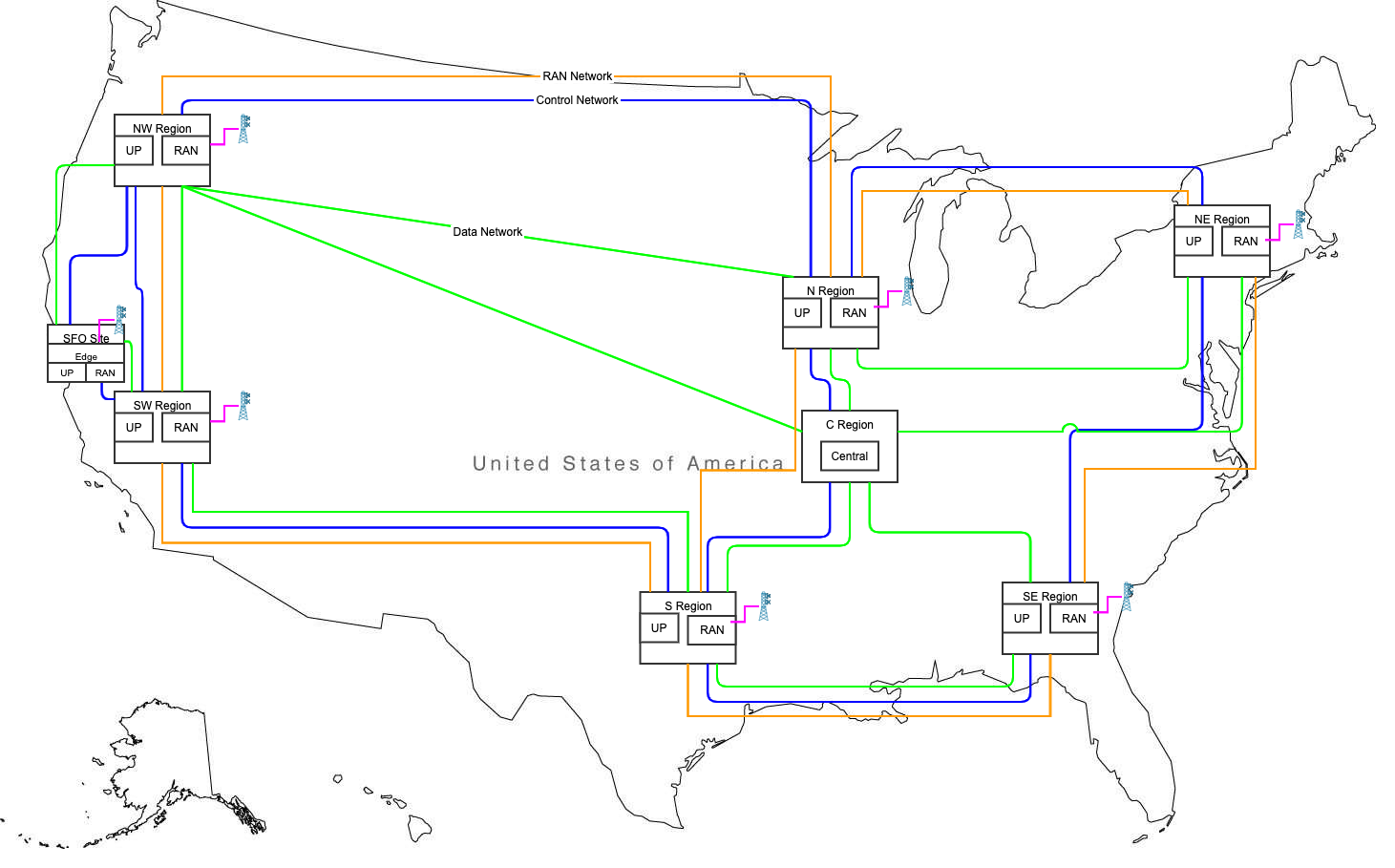
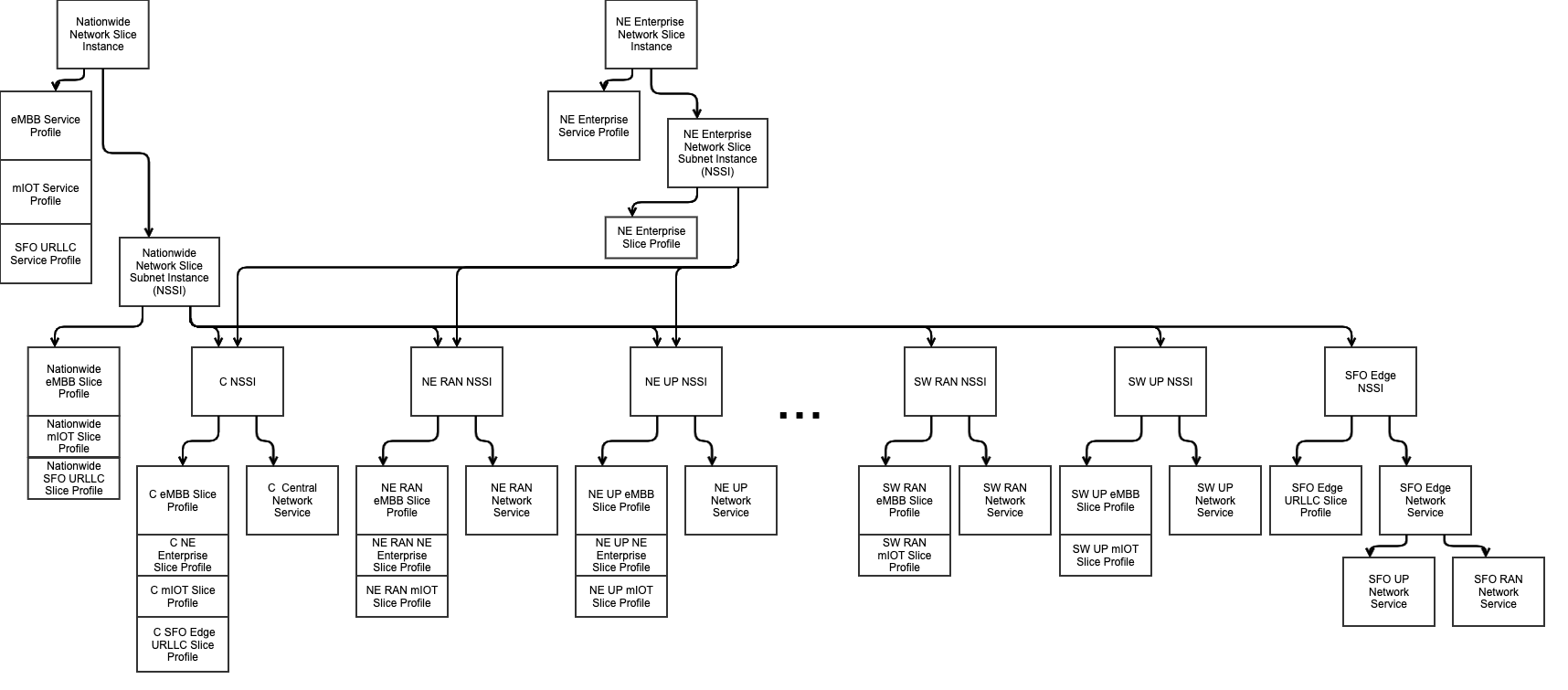
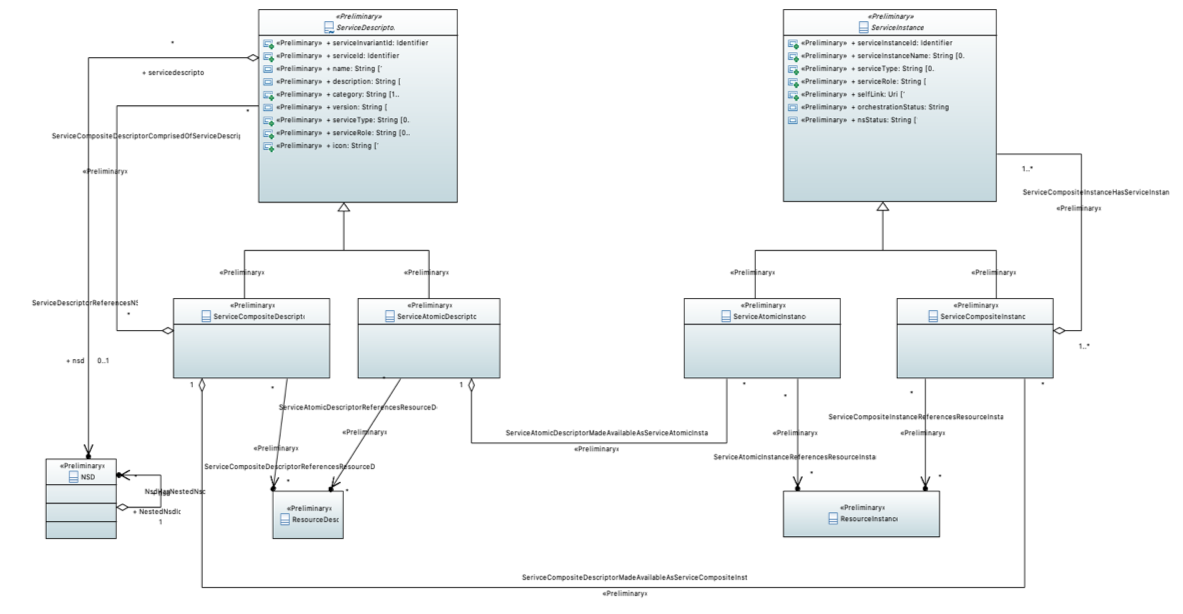

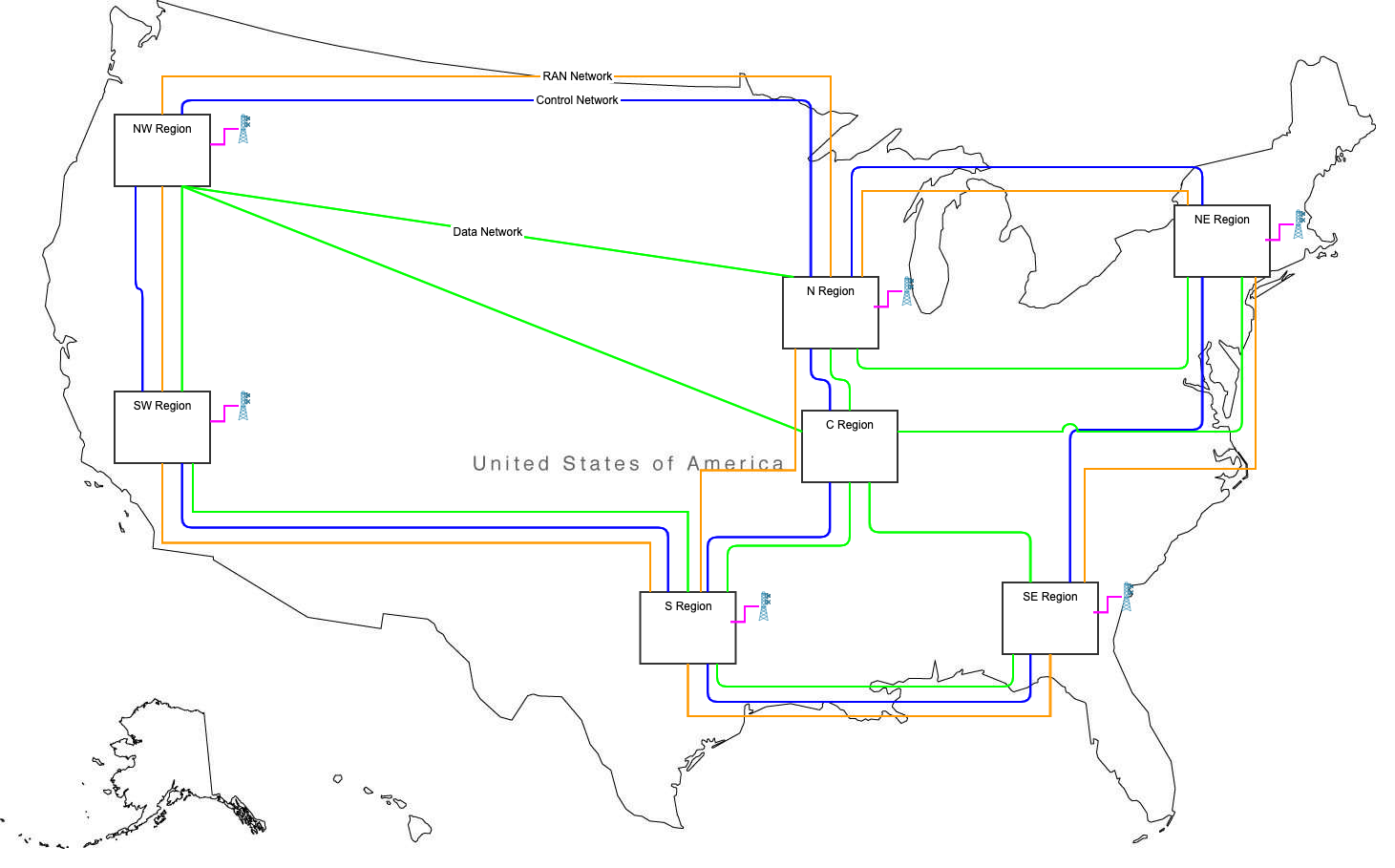
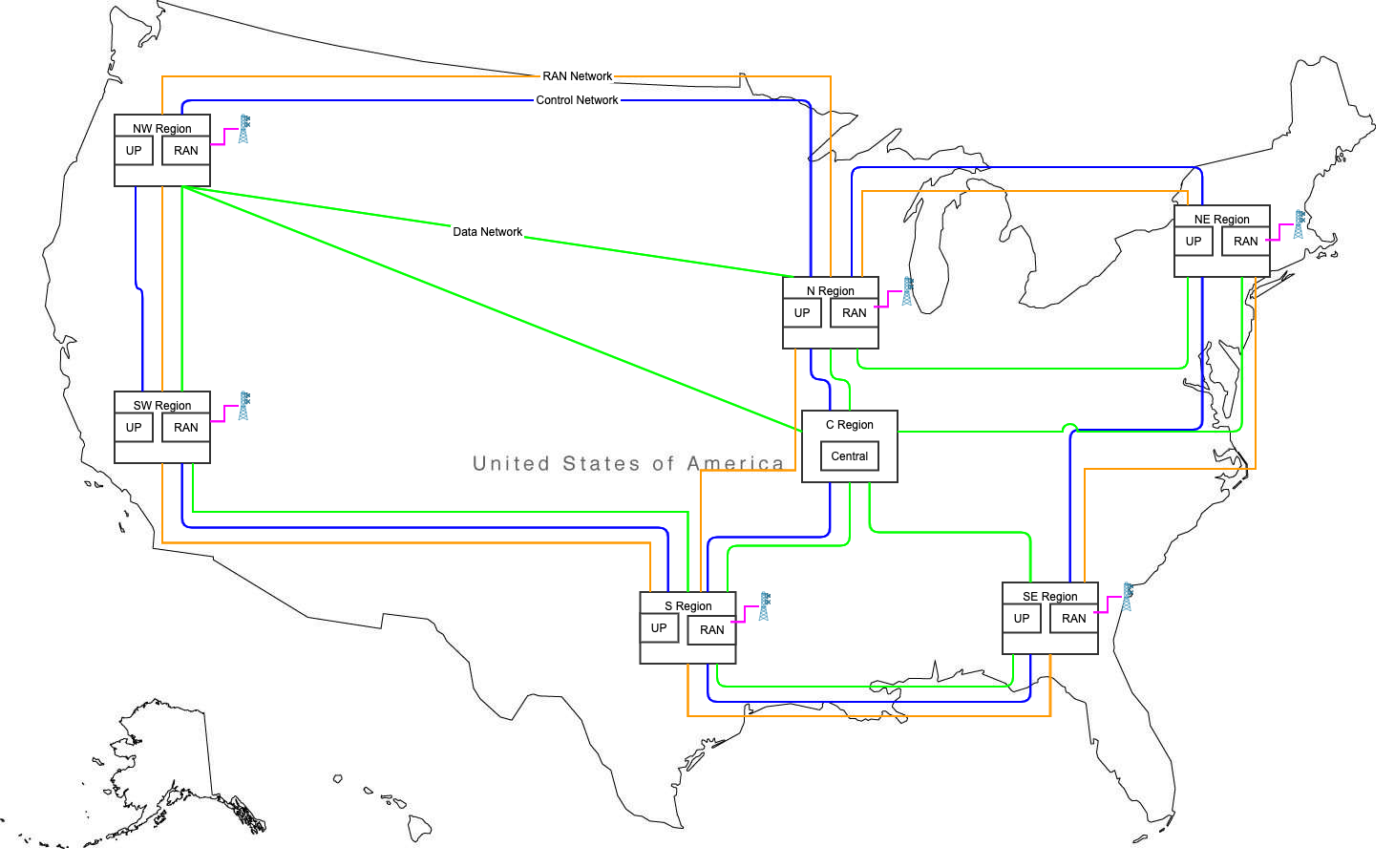
9 Comments
Kamel Idir
Hi Fred,
What about the modeling of NST and ServiceProfile?
Regards,
Kamel
Fernando Oliveira
HI Kamel,
I was unsure how to represent NST and Service Profile. From my reading of the 3GPP specs (28.541), it seems that NST would be represented by an ONAP Service Descriptor, but I don't know how to model ServiceProfile. One approach would be that ServiceProfile is created dynamically by CSMF based on input from a customer(#UE, QoS, latency, Area, ...). Perhaps we need to extend the ONAP IM with an NST derived from Service which includes a ServiceProfile. Probably also extend with an NSST derived from Service which includes a list of SliceProfile. Another approach might be to predefine some ServiceProfiles that a CSMF can pick from which would seem to require some design tool/mechanism in SDC.
Rene Tio
The terms "Network Slice Template" (NST) and "Network Slice Subnet Template" (NSST) appear deprecated as of v16.3.0. They appear to have replaced by "Service Profile" and "Slice Profile" if memory serves me well. Despite that it seems necessary to have some internal concept similar to a NST / NSST, which is how I read Fred's description of the Service package in steps 11-17 of design sequence. The other item of interest is that the Service Profile since v16.3.0 contains about 50% of the NEST almost verbatim. It is unclear whether the Service Profile is simply meant to carry the NEST in that case, between the CSMF and NSMF.
Fernando Oliveira
Hi Rene,
Yes, I came to the same conclusion that an internal concept of a "Service Descriptor" is needed and what I intended by the "XXX Network Slice Subnet Service Templates" above.
Chuyi Guo
NEST is used to carry SLAs, SLA management belongs to CSMF, however, service profile is more technique aspect to network, and this is consumed by NSMF. We have CST for SLA, after translation, the requirements from users will be mapped to service profile.
Rene Tio
I agree with these statements, I was just pointing out that the Service Profile contains much of the fields of the NEST. How each function (CSMF/NSMF/NSSMF) uses the information is specific to its function, so as you point out below the CSMF focuses on the "C", whereas the NSMF & NSSMF are more technology related.
Chuyi Guo
Hi Fred and Kamel,
In current implementation, we have separated templates for both side, NST, Service Profile T, NSST and Slice Profile T, NST and NSST can be used to deploy Nationwide instances, Service Profile T and Slice Profile T will carry dynamic customer requirements. The whole model design is at Design Service Templates ,you can seek for details.
Kamel Idir
Hi Chuyi,
Are we still modeling the CST (Communication Service Template) in Guilin as it has been done in Frankfurt?
The attached figure shows how GSMA GST attributes are used by 3GPP as inputs to network slice Network Resource Model (NRM) ServiceProfile and then further translated into relevant attributes of constituted network slice subnets SliceProfile.
Chuyi Guo
Hi Kamel,
Yes, we still has CST in Guilin to support CSMF function, but it is more appropriate to understand the "C" in CST as "Customer ", it is used for original user requirements(SLA).